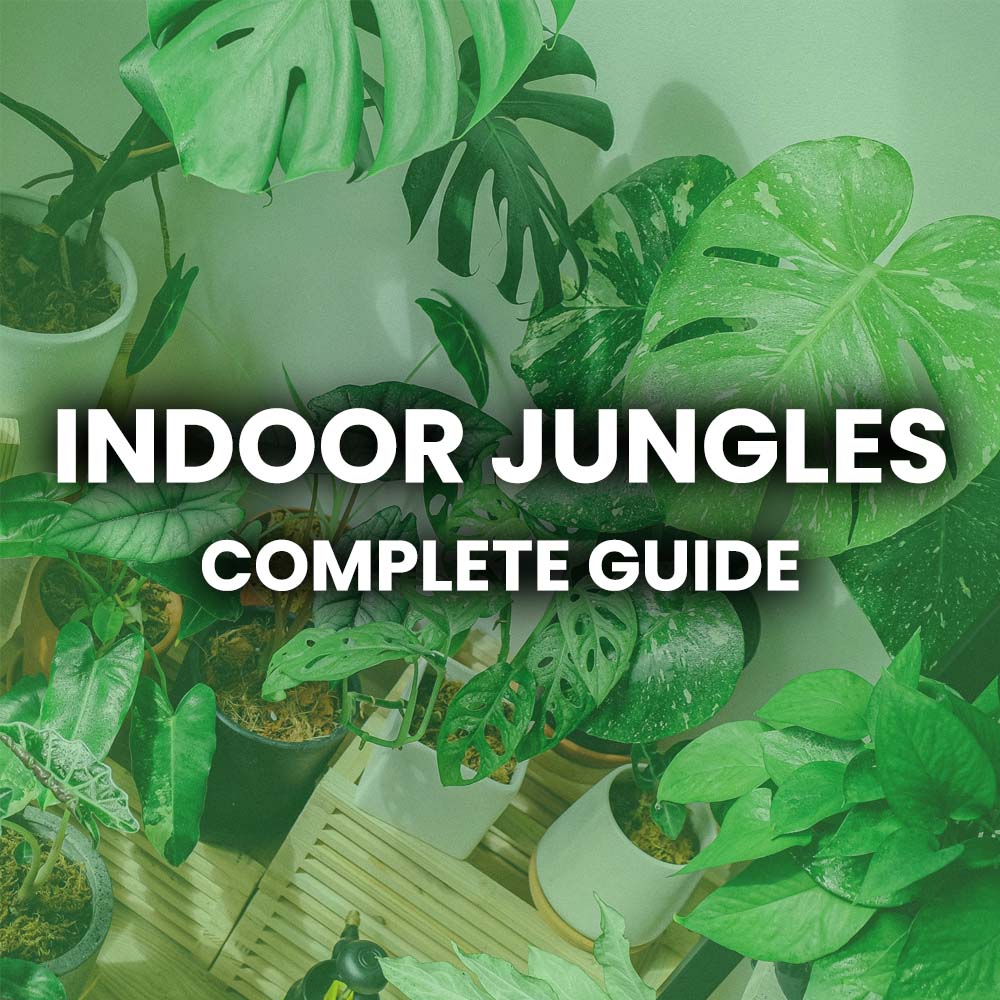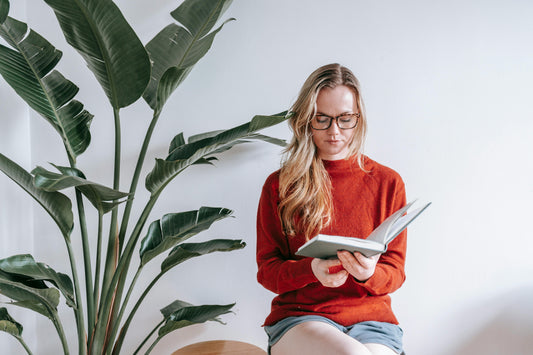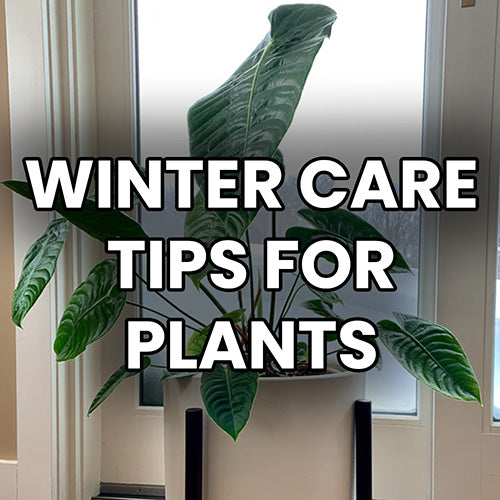
Indoor Jungles - What Are They? 5+ Benefits & More!
Share this with friends
Are you a plant lover looking to bring some greenery into your home? Look no further than the latest trend of indoor jungles. These spaces, filled with a variety of lush plants, create a tropical oasis within the walls of your home. Not only do indoor jungles add visual interest and a pop of colour to your home decor, but they also have numerous health benefits.
Studies have shown that being surrounded by plants and nature can improve air quality, reduce stress and anxiety, and even increase productivity. Plus, caring for plants can provide a sense of accomplishment and purpose.
With so many benefits, it's no wonder that indoor jungles are quickly becoming the ultimate trend for plant lovers.
Whether you have a green thumb or are just starting out on your plant journey, an indoor jungle is a must-have for any plant enthusiast.

What is an indoor jungle?
An indoor jungle is a collection of tropical house plants that are arranged in a way that creates a lush and tropical atmosphere. They are often comprised of a variety of plants of all different sizes, shapes, and colours.
Typically, indoor jungles are designed to be a tranquil, aesthetically beautiful space where you can enjoy yourself and feel at peace. They can also be used to add a touch of nature to a house or workplace.
Since they provide a number of advantages, such as better air quality, stress relief, and aesthetic appeal, indoor jungles have grown in popularity as a trend in home decor.
What are the benefits of an indoor jungle?
Over the years we have heard plant lovers discuss the benefits of their indoor jungles. Here are several benefits to having an indoor jungle:
1. Improved air quality:
As you know, plants breathe in carbon dioxide and other pollutants, and produce oxygen. Many indoor plants sold in plant stores are able to filter out harmful air pollutants, such as benzene, formaldehyde, and trichloroethylene. This can help improve the overall air quality in your home.
2. Stress relief and mental health benefits
Studies have shown that spending time around nature and plants can help reduce stress and anxiety levels. This is especially beneficial for people who live in urban areas that may not have much access to nature. With an indoor jungle, you are bringing nature to your own space.
3. The aesthetic appeal
Indoor jungles can add lots of personalized style, and a touch of greenery and beauty to a home or office space, creating a more pleasant and relaxing environment.
4. Improved general well-being
Being around plants has been shown to improve mood and increase feelings of overall well-being. This is thought to be due to the calming effect that plants can have on the mind and body. We also like to think that plants instill patience and understanding in everyone, as plants take time and attention to grow.
5. Increased creativity and productivity
Some recent studies have suggested that being around plants may help increase creativity and productivity, which we believe from first-hand accounts as well. This could be due to the fact that plants help create a more pleasant and relaxed working environment, which is why offices around the globe include plants in their standard decor.

Overall, your indoor jungle could provide you a range of physical and mental health benefits, as well as enhancing the aesthetics of your home or office space.
Tips to create your own indoor jungle
First off, you need to choose the right plants. Here at Gold Leaf Botanicals, we can help put together plants that are going to do well with the space you are working with.
Choosing the correct plants based on sunlight
It is best to select plants that suit the light levels your jungle will be receiving. If you have small windows, you will want plants that can tolerate low light levels, and vice versa for large windows. If your space gets direct sunlight it may be a problem for indoor tropical plants, and their leaves could burn from sun exposure. You may need to install blinds or some type of light filter to keep your plants happy.If you have any questions on which plants to choose, please reach out to our plant experts for some quick and friendly advice.
Different plant sizes, shapes, and colours
You also want to use a variety of different plant types and sizes. Be sure to mix and match different plant types and plant sizes to create diversity and visual interest and depth in your indoor jungle.
Trailing plants will be your friend if you have the room, as the trails can go up and down walls, climb up moss poles, and even be strung from the ceiling across the room. The possibilities are truly endless.
Adding pops of colour is easy when we are talking about tropical plants. There are reds, greens, white, pink, blue, orange, and all the colours of the rainbow out there. Mix in plants of all different colours to add depth and appeal.
Plant height is very important
Mixing up the height levels of each plant will make your indoor jungle customized to your liking, and your space.
For instance, you may have a plant that is hung high up from a ceiling hook that trails down. Next to that you may have a plant on a shelf, a large bird of paradise plant on the floor, or a plant that is climbing up a moss pole.
Group your plants together
We all have to start somewhere, and this is all to your preference. You could have 5 to 10 plants spread out through your room, or you could group them together in the corner next to chair you read in.
With endless possibilities you can do everything to your taste. We would be lying if we said we didn't move our plants around almost weekly. While you do have to be careful that you are not shocking your plants by changing the light intensity too drastically, you can always move your plants.
Mix up your indoor jungle!
Don't be afraid to experiment and have fun with your indoor jungle, after all, this is your space, and your refuge from this crazy world.

As you get more comfortable and confident with caring for your plants, you can add more plants or try different arrangements to create the perfect jungle-like atmosphere.
Watering and fertilizing your indoor jungle
With your plants chosen and arranged, watering and fertilizing your plant collection will be how you maintain your new paradise.
The care instructions for plants gets tricky, and we want to teach you what to look for, instead of giving absolute instructions. This will help you in the long run, but know that you will make mistakes, you will learn, and in the end you will become a plant expert yourself.
Watering your stunning jungle
Watering plants is not a one-size-fits-all solution. Large plants hold on to water longer than small plants. A lower humidity room will dry plants out faster. However, as you add more plants and moist soil to your space, the humidity will rise and change the watering frequency. Sunlight that enters the room will also affect water usage.
So how should you go about this? Most indoor plants come from tropical regions and live on the jungle floor. These regions receive low water, but the humidity is high.
Most plant lovers water too frequently and drown their plants. If you have killed a plant in the past, this was the likely cause. Your plants would rather be dry than wet. With that in mind, here is how we tell when a plant is thirsty.
It's leaves will tell you: If the leaves of your plant are not perked up, and they look deflated, or "sad", chances are their soil is dry, they have used the water stored in their stems and leaves, and they cannot hold themselves up.
This is a great time to lift your plant and feel how light it is. Remember this weight, and you can do this a few times. After the 4th or 5th lift you will know how much water is in the soil, and if it's time to add more.
How to water your jungle: When watering a plant there are two options, one long soak, or spaced-out smaller drinks.
You may soak your plant in water for 30 minutes to and hour, let it drain for 5 to 10 minutes, and place it back in the pot. Water it again when it's dry as described above. The other method is to give it one-third of the water and let it penetrate the soil. Then give it another drink, and another.
Soil that is extremely dry will actually repel water, and moist soil attracts more water. Smaller waterings will hydrate the soil enough so more water can re-hydrate the soil throughout the plant.
Fertilizing Your Indoor Jungle
Plants use the sunlight, water, and fertilizer to grow healthy and strong. You are likely giving your plant sun and water, but eventually you will need to add more food.
You can use liquid plant fertilizer, a dry plant fertilizer, or a combination of plant fertilizers together, and we have a few options for you to try.
It is best to follow the instructions on the label. Be sure to start with 50% of what the bottle says to see how your plant responds. You don't want to burn your plant with too many nutrients, and you can always give your plant more if needed.
Get started on your indoor jungle today!
It's easier than you might think to get started. Try choosing low-maintenance plants like pothos, snake plants, or succulents, or start with small plants or cuttings if you're new to gardening.
For tips and advice, check out plant care guides where you can get advice from more experienced gardeners.
And don't be afraid to show off your own indoor jungle – share photos on social media or in your blog to inspire others to join in on the fun.





